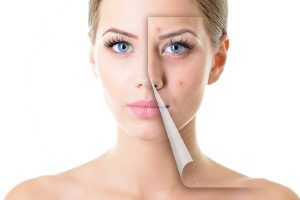
Acne is one of the most troublesome and common skin-care problems for people around the world—and emotionally one of the most debilitating and embarrassing skin disorders to experience. I had very bad acne when I was younger, and it was not fun. Although acne is most often associated with teenagers and the onset of puberty, the truth is that you can get acne at any age, which makes it even more frustrating.

So, What is Acne Anyway?
Knowing what causes acne is your first step in learning how to take control so you can get rid of breakouts and get back to having clear skin!
Most of us are familiar with acne, even if we don’t know the specifics of what makes it acne and not some other skin problem. Acne’s textbook definition is, a skin disorder that occurs when hair follicles (every pore on your face is actually part of a follicle) become plugged with dead skin cells and oil. That mixture of oil and cells allows the bacteria responsible for acne, Propionibacterium acnes (P. acnes), to flourish inside the follicle instead of remaining on skin’s surface, where it normally resides without causing much trouble.
The bacteria feasts on the follicle’s contents, which starts a domino effect by producing inflammatory chemicals and enzymes. This process attracts white blood cells to combat the bacteria, which leads to inflammation. Acne is first and foremost an inflammatory disorder, and it’s important to remember that when treating it!
Anything you can do to reduce inflammation will help acne heal faster, the reverse is true as well, making the inflammation worse will make the acne worse!
Forms of Acne
Acne can show up on many areas of the body, including the face, neck, chest, back, shoulders, and arms and it can take several forms, as described below.

- Comedones: This form of acne presents itself in two ways: whiteheads or blackheads. Comedones are the non-inflammatory version of acne. When these lesions are closed at the skin’s surface, they are flesh-colored, slightly raised bumps called whiteheads. When they’re open, the exposure to air allows the plugs in the hair follicle to oxidize, resulting in a dark or black spot on skin called a blackhead. That dark spot is not dirt showing beneath the surface of skin!
- Papules: These are small, raised bumps that indicate inflammation is occurring in hair follicles.
- Pustules: Larger than papules, these red, tender bumps have white pus at their tips and are a sign of a more advanced, deeper inflammation.
- Nodules: One of the most painful forms of acne, these bumps remain below the surface of the skin and are large and solid. They develop when buildup occurs deep within hair follicles that are severely clogged.
- Cysts: Painful, pus-filled lumps that form beneath the skin, and that present an increased risk of scarring due to their depth and collagen-destroying potential..

How to Treat Acne
The good news is that there is a wealth of information about the different ways to treat acne and bring it under control. This is a battle that can be won—and the feeling of happiness when you finally have clear skin again is among the best ever, trust me!
It is best to gently cleanse and then exfoliate your skin with a Retin A type cream. Below are some products that can be used to help treat your acne but it is best to have a complimentary skin care consultation to identify which will work the best for you.
Cosmedix:
Purity Clean (Exfoliating Cleanser)
Clarity (Blemish-Fighting Serum)
Define (Resurfacing Night Treatment)
Reflect (Ultra Light Weight SPF that does not clog pores)
Schedule your complimentary consultation at the Laser Image Company and let us help you get to the clear skin you deserve.



